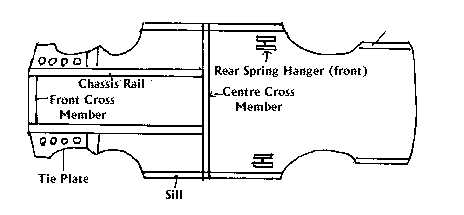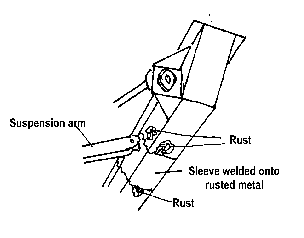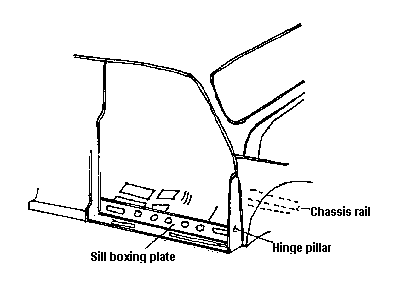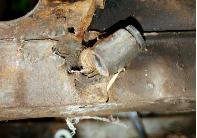| technical main | restoration | hints and tips | the A-series engine | voltage regulator | mazengarb conversion | clutch |
TECHNICAL ARTICLES © Morris Minor Car Club of Victoria Inc.
Notes on Buying a Morris Minor
Okay, so you want to buy a Morris Minor - or you think you do! Before taking the plunge think carefully about what sort of car you want and how you will use it. Most Morris Minors in Australia are now 50+ years old and were not designed for the driving conditions of these days.
Don't expect a Morris Minor to keep up with modern traffic - there is no way that one can accelerate or stop like a modern car. The Morry even has difficulty keeping up with buses and trucks - especially going up hills!
And don't buy one for cheap transport - old cars take a lot of work to keep going which can be expensive unless you do the work yourself. So a Morry is fine as a hobby car but not really the vehicle to chose for every day transport.
Which Morris Minor?
The Morris Minor was produced in a surprisingly large range of models. The Minor two-door was made in the greatest numbers and is probably still the most common model. The four door Minor has the advantage of easier access to the rear seat and more windows to open on hot days!
The Traveller (or Woody) probably ranks as the "top of the range" of the Morris Minor models. Its wooden framework gives it a very pleasing and unique character. However, this model was not sold in Australia and they are fairly rare. It is probably the most versatile model with excellent space for seating or a long flat loading bay.
One of the most delightful models to drive is the Minor Tourer or convertible. However, on cold and wet winter days it may not be the most comfortable car with the inevitable draughts and leaks that soft-top cars are prone to have.
Finally, there is the Minor Van, which has the attraction of having the greatest load carrying capacity of any model of Minor.
Series MM (Sometimes referred to as Series 1 or Low Light)
The MM is the earliest of the Morris Minors and the only model that can be classified as a "true" Morris produced by Morris Motors Ltd.
The MM is fitted with the pre-war side-valve engine that was used in the Morris Eight and consequently tends to be underpowered.
The car was produced with a split windscreen and with headlights originally situated beside the grill (low light). The headlights, after two years, were raised to the more common "high light"position in the front guards.
Parts for these earlier cars are sometimes a little more difficult to obtain.
This is a slow car and not suitable for every day use but rather the choice of the serious collector of Morris Minors.
Series II
The Series II was produced after the merger of Morris and Austin into the British Motor Corporation. It was the first production Morris Minor to be fitted with an overhead valve engine.
The engine was the Austin A-Series with a capacity of 803cc as used in the Austin A30. The car was considered satisfactory for English roads but gained a poor reputation overseas for having a weak engine and a gearbox with unsatisfactory ratios. It has been referred as the car with an engine fitted with a crankshaft made from a piece of bent wire!
The Series II was still produced with a split windscreen which was probably old fashioned even in the early 1950's!
This model cannot be recommended, unless is has been fitted with the superior engine and gearbox from a 1000.
Minor 1000 (Sometimes referred to as Series III)
This series of Minor was fitted with a slightly larger engine of 948cc and a new gearbox. The combination of a larger and stronger engine, and an improved gearbox, produced a more reliable and sprightly car.
The Minor 1000 was also fitted with a single piece windscreen and a larger rear window greatly improving visibility all round. This was probably the most popular series of Morris Minor in Australia and consequently most spare parts are still readily available.
This is probably the best series for every day use or even for a club run in the country!
During 1962, the Minor 1000 was fitted with a larger 1098cc engine and a much improved transmission.
But, production of the Morris Minor ceased in Australia before this model was released and was largely replaced by the Morris Major and then the Mini.
However, most of this Series were fully imported into Australia.
Hints on How to Buy a Good Morris Minor
Morris Minors are now between 36 and 60 years old and unless meticulously looked after may well contain serious faults.
Probably rust ('cancer' of old cars!) is the worst enemy of the Minor and very common in cars of this age.
To assess the condition of a Morris Minor takes time, skill and experience, and should be undertaken by a person with some mechanical knowledge.
Therefore, it is recommended that after a car has been found, it should be inspected by an expert (of Morris Minors!) before purchasing it.
If not, then before purchasing a Morris Minor, inspect it very carefully.
Otherwise you may find restoration too expensive. Don't get caught like the author was and have to scrap the car.
Unless an expertly renovated Minor is purchased, it is unlikely that a car will be found without some faults. It is therefore necessary to decide which faults can or can't be lived with either in the short or long term, and let the cost of repairing the faults be the main determining factor in buying the car.
It is suggested that a prospective car be checked in the following order:-
1. External Appearance.
The outside appearance of the car is some indication of how carefully the car has been maintained.
- Is the paintwork in good condition, free from rust (bubbles under the paint), damage and ripples caused by panel beating? Note that the front wings are prone to corrosion around the headlights and adjacent to the doors.
- Examine the boot lid for corrosion, especially along the bottom. Check inside the boot for corrosion at rear of the body floor, rear outer corners, rear bumper bar mounting areas (try lifting the bumpers), and rear wing mounting areas.
- Are the door and window frame gaps even? Doors with gaps or which stick out may indicate damaged or a rusted sub-chassis. Attempt to lift the door and then lower - movement in the hinge pillar may indicate corrosion of the pillar at the base.
- Examine lower face of door skin and base of door for corrosion.
- Check the quality of chrome work.
- Turn on all the lights and indicators and check that they work.
- Bounce each corner of the car several times to check shock absorbers. The car should quickly return to equilibrium.
- Check the condition of each tyre for uneven wear or cracked walls. Each pair (front or rear) should be of the same type - radial or crossply.
- Examine condition of the interior - abuse may indicate a poorly looked after vehicle that can be expensive to repair.
2. Underbody.
The underbody structure is crucial to the overall strength and safety of the car. It is imperative that this area is examined thoroughly, preferably by lifting the car up on stands, ramps or a hoist. It should be noted that any visible rust found on the outside is likely to be considerably worse on the inside once the panel has been removed. A heavy object such as a screwdriver or hammer should be used to tap the floor and major chassis members to detect weakened areas.

Ensure when working under a car that the wheels are chocked, and ramps or stands are used. Never go under a car only supported by a jack.
- Begin with the floor pan as strength of this area is vital to the integrity of the car. Carefully examine for rusted areas - if possible remove the carpet.
- Check the front most cross member which links the two longitudinal chassis rails ahead of the engine. This is prone to rust, particularly where the ends meet the chassis rails, and on the left side if the radiator water overflow plastic extension pipe has been missing.
- The inner wings should be examined including the front wheel arch panel (flitch panel) this forms the vertical engine compartment sides.
- A pair of chassis rails run from the front to a cross member under the seats. The front engine mountings, torsion bar front mounts and suspension bottom arms and tie rods are fixed to these members. Tap the members thoroughly along their length with the head of a hammer. The chassis rail may appear to be perfectly sound but may actually be paper thin. The chassis rail is also prone to fatigue and crack around the eyebolt.
- Also, inspect these member for repairs - it is not unusual for them to be patched and then re patched to such an extent that they are no longer safe.
- Check the front suspension mounting where it is attached to the eye bolt. The eye bolt passes through the chassis rail. If the bolt is at an angle and/or touches the tie plate 'floor' at the top of the box section of the chassis rail, then the chassis rail has corroded and collapsed. In extreme cases the suspension arm may have dented the tie plate 'floor'.
- The chassis rails are welded onto a cross member that passes across and underneath the floor. The rear torsion bar mounts and jacking points are attached to this member. Check carefully for corrosion and signs of repairs.
- Examine the sills or chassis sub frames underneath the doors. These are not easily assessable without removing the kick plates. Try to examine the sills with the carpet and trims removed. Check the area where they meet the front inner wheel arch. Examine them along their length, particularly at the base where they abut the floor and all the way back to the rear seat support. This area may be patched over with sheet steel which may weaken this area.



The sill areas below the doors are prone to rust.
- The front of the rear springs fix to plates welded to the rear floor. The area where the spring hangar is should be carefully examined as well as the floor from inside the car.
- Above the front rear spring hangars is the support section for the front of the rear seat base. Where this joins with the floor is a common point for rust.
- The rear of the rear springs are connected to the continuation of the chassis rails by shackle brackets, the box section of this chassis rail is prone to rust.
3. Mechanicals.
Check the condition of the exhaust system.
Engine:-
- Remove the radiator cap and check for rusty water (an indication that the coolant hasn't been changed for a long time) and oil (an indication of head gasket problems or a cracked head or engine block).
- Examine the radiator for damage or leaks.
- Remove the dipstick - the presence of water in the oil indicates head gasket problems (or a cracked head or engine block).
- Examine engine mounting brackets for damage and rubber mounts for perishing.
- Remove oil filler cap - a yellow or brown sludge indicates possible bore or valve guide wear.
- Check the starter motor - a motor that turns the engine over slowly may be faulty or could indicate a poor battery or electrical connections.
- Switch on the ignition and check that the oil and ignition lights are working.
- Start the engine and let it thoroughly warm. Check that the ignition light goes out indicating that the generator is charging the battery. Check that the oil light goes out indicating engine oil pressure. Listen to the engine, bottom end rumble may indicate crank wear, front end tinkle timing chain wear and top end tapping possible tappet wear.
- Check the engine for the presence of oil leaks (minor oil leaks are not unusual!).
Steering/Suspension:-
- Push and pull on steering wheel -clonking or looseness may indicate worn column bush, loose steering wheel, etc.
- Turn the steering wheel back and fourth and check for free play. There should be little or no free play.
- Jack both front wheels off the ground. Turn steering wheel from lock to lock - roughness or tight-spots indicates wear in the steering rack.
- With the front wheels off the ground, grasp each front wheel top and bottom and try to rock the wheel. Any more than a small amount of play will indicate wheel bearing wear.
- With a jack under the wishbone arm, carefully raise the front wheel and check the upper and lower king pin threads and bushes for wear. It should be noted that any looseness in the king pin to upper or lower linkages could lead to serious failure, by the king pins pulling out.
Brakes:-
- Check metal brake pipes for corrosion and leaks. Examine rubber front brake hoses, and hose to rear axle, for cracks and leaks.
- Examine the inside of tyre and brake backing plates for signs of fluid leakage.
- Press down on the brake pedal for a minute or two, if it sinks slowly there may be a hydraulic leak or the master cylinder may be faulty.
Transmission:-
- Check for oil leaks from the gear box.
- Check for oil leaks from rear axles and differential.
- Check the propeller shaft universal joints for wear.
4. Road Test:-
- Test the gearbox at various speeds and conditions of acceleration. Check for noise, difficulty of engaging gears and slipping out of gear.
- Check for shuddering or noisy clutch. If shuddering, check wire brace from gearbox to cross member and engine brace from cylinder head to firewall.
- Check that the brakes stop the car evenly and without excessive force having to be exerted on the brake pedal. Also listen for squealing or grinding noises when applying the brakes.
- Is the engine noisy and does it lack power? Check for excessive smoke from the exhaust especially when driving off and accelerating.
- Check that the front wheels do not flutter or shake at speed.
- Listen for front suspension clonks - especially when driving over rough roads or applying brakes.
- Drive at 50 KM/H ( 30 MPH) and release the accelerator - listen for differential whine.
- With car stopped and hand brake firmly applied, slowly let out clutch pedal and check for slipping clutch.
The above list is by no means complete. I would strongly recommend the intending purchaser of a Morris Minor to buy or borrow the excellent book by Lindsay Porter or the other books listed below, from which I acknowledge obtaining many of these ideas.
The above check list does appear to be daunting. However, when purchasing an old car it is almost a certainty that numerous faults will be found in almost every car examined.
A final word of warning, never trust a Road Worthy Certificate to indicate that a car is free from faults.
References:-
1. Morris Minor & 1000 - The guide to Purchase and DIY Restoration by Lindsay Porter
2. Morris Minor - The World's Supreme Small Car by Paul Skilleter
3. Morris Minor 1000 Owner's Workshop Manual by J H Hayne

